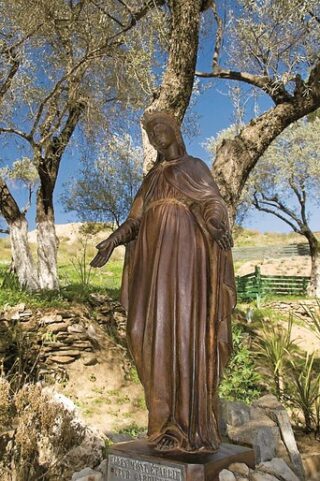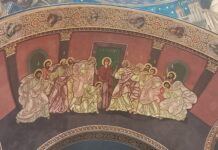Even if you’ve been to Ephesus before, be sure to do it again if you find yourself in the Izmir region of Turkey. The remains of the ancient city were discovered in 1863, and only 37% of it has been discovered and preserved today, but archaeologists continue to work and Ephesus reveals more and more of its ancient secrets.
Recently, Ephesus, a UNESCO World Heritage Site, has a new interactive museum that will immerse you, with all your senses, in the thousand-year history of one of the best-preserved ancient cities in the world.
Ephesus Experience won top honors in the Best Museum category at this year’s MONDO-DR Awards. The awards are among the most prestigious in the fields of technology, design and exhibitions in the world and this year they were presented in June in Las Vegas, USA.
The awards, organized by MONDO-DR magazine, were established in 2017 to honor the best installation projects in the world. Over time, the awards began to also celebrate achievements and best projects in the exhibition and hospitality sector, focusing on the design of exhibition venues, visitor experiences and technical installations. The Ephesus Experience Museum was awarded the prize, thanks to the high evaluation of an independent jury, which recognized the project as outstanding worldwide.
An immersive symphony
The Ephesus Experience is one of the first museums in the world to combine experiential museology with age-old storytelling. As one of the most intriguing destinations on Turkey‘s Aegean coast and one of the most significant ancient cities in the world, Ephesus attracts thousands of tourists every year. In addition to being known as one of the greatest port cities of its time, it was also included in the UNESCO World Heritage List in 2015. Using innovative technology, the Ephesus Experience museum gives visitors the opportunity to personally experience the daily life, trade, architecture and art of the city during these golden ages.
Developed by DEM Museums, the Ephesus Experience was designed by a large team including architects, curators, designers, artists, technology experts, historians and archaeologists from leading companies and academic institutions in Turkey and around the world. The museum immerses you in an unforgettable journey in which you walk the streets of Ephesus, peer into the secrets of the ancient world and touch everyday life in the past.
Ephesus has existed since the Neolithic, but gained importance during the Roman Empire as the capital of Asia Minor and a very important port. As the second most important city in the Roman Empire, it grew and flourished. Its population of about 250,000 people – metropolis in the context of ancient times, is mostly educated and wealthy, and its buildings are richly decorated and speak of the interests and well-being of its inhabitants.
Today, Ephesus is not on the seashore – the passing river for centuries brought sediment to the port and eventually clogged it. The city’s decline also coincided with disasters such as the plague and an earthquake in the 12th century. In the following years, the city continued to exist, only to be finally abandoned in the 15th century.
Landmarks in the ancient city include the Library of Celsus and the Great Theatre, which has a capacity of 30,000 spectators; the ruins of the Temple of Artemis; The Gate of Mazeus and Mithridates; the temple of Hadrian and the terrace houses.
In ancient Ephesus, they worshiped the Mother Goddess, symbolizing fertility, who gradually acquired the image of the Hellenic goddess of hunting and nature, Artemis. In her honor, one of the Seven Wonders of the Ancient World was erected in Ephesus – the Temple of Artemis, of which only parts of columns remain, unfortunately.
One of the grandest and best-preserved buildings is the Library, which was also a university. It is the third largest library in the Greco-Roman world after Alexandria and Pergamon. Unlike the first two, however, here the library is amazingly preserved. And across from her is the brothel.
The two buildings were connected by a tunnel.
On the street in front, on the port side, probably the first advertisement of the place for carnal pleasures has been preserved – it guides sailors and all those who want to find love.
The public toilets, which were a place for active social life, have also been preserved. Dozens of sufficiently large holes are drilled in the stone “benches”, a channel with running water runs below. There was also a fountain with scented jets for freshness. The slaves had to warm the cold stone with their bare bottoms before their masters took their turn.
The recently opened terraced houses of Ephesus are also impressive. Three residential complexes have been preserved, only one is open to visitors. It consists of several residences on an area of 2500 sq.m. – on three terraces one above the other, directly opposite Hadrian’s Temple.
Remains of a private bath, a huge reception hall with painted walls and red and green marble cladding are preserved. The houses were built in 1st century, they were last inhabited in the 12th century.
The House of the Virgin Mary, in which the Virgin is said to have lived after the resurrection of Jesus, is very close.
“The abode of the Blessed Virgin Mary was not located in Ephesus itself, but three to four hours away. It stood on a height where several Christians from Judea had settled, among them holy women, her relatives. Between this height and Ephesus a small river flowed with many crooked curves.” This is the vision of the nun and clairvoyant Anne Catherine Emmerich, according to which the house was discovered in the 19th century.
In 1822, the Blessed Virgin appeared before her and described in detail the place where she lived until her Assumption. Everyone believed the nun unconditionally, because they knew that she had never left Germany. When pilgrims set out to verify the fortune teller’s words, in Turkey – in Ephesus, at the place indicated by Anne Catherine, they actually found a house that exactly matched the one described by the nun.
After the nun’s death, her visions were published in a book by Clemens Brentano. The Catholic Church has not ruled for or against the house’s authenticity, but has nevertheless maintained a steady stream of pilgrimages since its opening. Anne Catherine Emmerich was beatified by Pope John Paul II on October 3, 2004.
The House of the Virgin is not by chance in Ephesus – the ancient city played a large role in early Christianity.
Tradition claims that Ephesus is the city where St. John the Apostle came with Mary after the resurrection of Christ. In the Gospel of St. John we read: “When Jesus saw his mother and the disciple whom he loved standing near him [by the cross], he said to his mother: ‘Mother, behold your son!’ Then he said to the disciple: ‘Behold your mother!’ From that moment on, this disciple took the mother of Jesus into his own home” (19:25-27).
Next to the house of the Mother of God, a spring with healing water gushes out from under the ground. Around it is a wall where everyone can write their wish. Tie a handkerchief or ribbon to the specially placed grid and say out loud what you dream about.














 English
English French
French Spanish
Spanish German
German Dutch
Dutch Italian
Italian Danish
Danish Portuguese
Portuguese Greek
Greek Russian
Russian Swedish
Swedish Bulgarian
Bulgarian Hungarian
Hungarian Catalan
Catalan Ukrainian
Ukrainian Polish
Polish Basque
Basque Chinese (Simplified)
Chinese (Simplified) Japanese
Japanese Hebrew
Hebrew Arabic
Arabic Swahili
Swahili Amharic
Amharic Irish
Irish Afrikaans
Afrikaans Albanian
Albanian Armenian
Armenian Azerbaijani
Azerbaijani Belarusian
Belarusian Bengali
Bengali Bosnian
Bosnian Cebuano
Cebuano Chichewa
Chichewa Chinese (Traditional)
Chinese (Traditional) Corsican
Corsican Croatian
Croatian Czech
Czech Esperanto
Esperanto Estonian
Estonian Filipino
Filipino Finnish
Finnish Frisian
Frisian Galician
Galician Georgian
Georgian Gujarati
Gujarati Haitian Creole
Haitian Creole Hausa
Hausa Hawaiian
Hawaiian Hindi
Hindi Hmong
Hmong Icelandic
Icelandic Igbo
Igbo Indonesian
Indonesian Javanese
Javanese Kannada
Kannada Kazakh
Kazakh Khmer
Khmer Korean
Korean Kurdish (Kurmanji)
Kurdish (Kurmanji) Kyrgyz
Kyrgyz Lao
Lao Latin
Latin Latvian
Latvian Lithuanian
Lithuanian Luxembourgish
Luxembourgish Macedonian
Macedonian Malagasy
Malagasy Malay
Malay Malayalam
Malayalam Maltese
Maltese Maori
Maori Marathi
Marathi Mongolian
Mongolian Myanmar (Burmese)
Myanmar (Burmese) Nepali
Nepali Norwegian
Norwegian Pashto
Pashto Persian
Persian Punjabi
Punjabi Romanian
Romanian Samoan
Samoan Scottish Gaelic
Scottish Gaelic Serbian
Serbian Sesotho
Sesotho Shona
Shona Sindhi
Sindhi Sinhala
Sinhala Slovak
Slovak Slovenian
Slovenian Somali
Somali Sundanese
Sundanese Tajik
Tajik Tamil
Tamil Telugu
Telugu Thai
Thai Turkish
Turkish Urdu
Urdu Uzbek
Uzbek Vietnamese
Vietnamese Welsh
Welsh Xhosa
Xhosa Yiddish
Yiddish Yoruba
Yoruba Zulu
Zulu